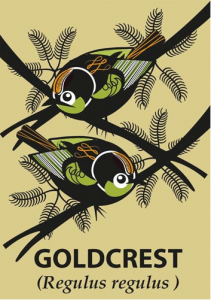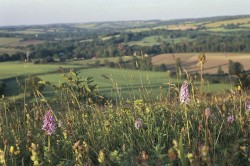The South Downs has many different types of habitats due to the type of land, weather patterns and the way that the land has been managed. These habitats include chalk downland, lowland heath, woodland, wetland and rivers, farmland, coastal and marine. Many rare and important wildlife species live in the South Downs.
Sheep-grazed downland is the main habitat of the chalk landscape. Southdown sheep are a local breed that eat the grass and encourages lots of other species in the area.
The greensand of the Western Weald contains important lowland heath habitats including Woolmer Forest. This is the only site in the British Isles where all our native reptile and amphibian species are found.
West of the River Arun the National Park is more wooded. There are important features such as the ancient yew woodland and the magnificent ‘hanging’ woodlands.
A large percentage of the National Park is farmland. Farmland includes important wildlife habitats such as hedgerows, arable land, semi-natural grassland and dew ponds.
The river valleys that cross the South Downs support wetland habitats and a wealth of birdlife.
Resources Toolbox
General Interest
All Ages
-

Chalk Grassland
Introducing chalk grasslands - the European equivalent of tropical rainforests. Covers what they are, where they are found, how they were formed and why its important to look after them. Also looks at what is being done locally in the South Downs to conserve and improve them for the future. -

Forest Snapdragon
Make a simple paper game then play it with friends to learn more about the forest. Created by the Forestry Commission. -

National Parks England - Wildlife Wonders
National Parks provide valuable spaces for nature on a large scale, with special protection for wildlife. Map and infographic of the wildlife highlights in England's National Parks.
EYFS
Ages 1–5
Pre School
Key Stage 1
Ages 5–7
Years 1 and 2
-

Arun and Rother River Explorer
A curriculum-linked resource pack for teachers of key stages one and two -

Bee Scene Botanical Adventure
An activity to find out how good your local area is for bumblebees. Record your results then share them on the Bee Scene website. -

Bee Scene Education Pack
A resource pack full of ideas for activities and expeditions in your local area. Bee Scene will help you find out about wild flowers and bumblebees. -

Bee Scene Flower Identification Chart
A colourful identification chart to help you find flowers that the bumblebees prefer. -

Chalk Grassland Colouring Sheets
Six A4 colouring sheets with some of our best chalk grassland species. -

Heathland Colouring Sheets
Seven A4 colouring sheets of people, wildlife and sculptures inspired by the communities and stories of our heathlands. -

Heathland Top Trumps
A set of 13 top trumps style cards with images and information about heathland specialist species.
Key Stage 2
Ages 7–11
Years 3, 4, 5 and 6
-

Arun and Rother River Explorer
A curriculum-linked resource pack for teachers of key stages one and two -

Bee Scene Botanical Adventure
An activity to find out how good your local area is for bumblebees. Record your results then share them on the Bee Scene website. -

Bee Scene Education Pack
A resource pack full of ideas for activities and expeditions in your local area. Bee Scene will help you find out about wild flowers and bumblebees. -

Bee Scene Flower Identification Chart
A colourful identification chart to help you find flowers that the bumblebees prefer. -

Chalk Grassland Colouring Sheets
Six A4 colouring sheets with some of our best chalk grassland species. -

Heathland Colouring Sheets
Seven A4 colouring sheets of people, wildlife and sculptures inspired by the communities and stories of our heathlands. -

Heathland Top Trumps
A set of 13 top trumps style cards with images and information about heathland specialist species.
Key Stage 3
Ages 11–14
Years 7, 8 and 9
-

Bee Scene Botanical Adventure
An activity to find out how good your local area is for bumblebees. Record your results then share them on the Bee Scene website. -

Bee Scene Education Pack
A resource pack full of ideas for activities and expeditions in your local area. Bee Scene will help you find out about wild flowers and bumblebees. -

Bee Scene Flower Identification Chart
A colourful identification chart to help you find flowers that the bumblebees prefer. -

Chalk Grassland
Introducing chalk grasslands - the European equivalent of tropical rainforests. Covers what they are, where they are found, how they were formed and why its important to look after them. Also looks at what is being done locally in the South Downs to conserve and improve them for the future. -

Heathland Top Trumps
A set of 13 top trumps style cards with images and information about heathland specialist species.
Key Stage 4
Ages 14–16
Years 10 and 11
-

Chalk Grassland
Introducing chalk grasslands - the European equivalent of tropical rainforests. Covers what they are, where they are found, how they were formed and why its important to look after them. Also looks at what is being done locally in the South Downs to conserve and improve them for the future. -

NGOET Grey Partridge Presentation
An excellent presentation about the conservation of the grey partridge on farmland from the National Gamekeepers Organisation Education Trust. Contains a case study from the Norfolk Estate, illustrated by figures and maps.
Key Stage 5
Ages 16–18
Years 12 and 13
-

Chalk Grassland
Introducing chalk grasslands - the European equivalent of tropical rainforests. Covers what they are, where they are found, how they were formed and why its important to look after them. Also looks at what is being done locally in the South Downs to conserve and improve them for the future. -

NGOET Grey Partridge Presentation
An excellent presentation about the conservation of the grey partridge on farmland from the National Gamekeepers Organisation Education Trust. Contains a case study from the Norfolk Estate, illustrated by figures and maps.










